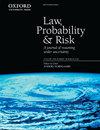Value of evidence in the rare type match problem: common source versus specific source
IF 1.4
4区 社会学
Q1 LAW
引用次数: 3
Abstract
In the so-called rare type match problem, the discrete characteristics of a crime stain have not been observed in the set of background material. To assess the strength of evidence, two competing statistical hypotheses need to be considered. The formulation of the hypotheses depends on which identification of source question is of interest (Ommen, 2017, Approximate statistical solutions to the forensic identification of source problem. (Phd thesis). South Dakota State University). Assuming that the evidence has been generated according to the beta-binomial model, two quantifications of the value of evidence can be found in the literature, but no clear indication is given when to use either of these. When the likelihood ratio is used to quantify the value of evidence, an estimate is needed for the frequency of the discrete characteristics. The central discussion is about whether or not one of the traces needs to be added to the background material when determining this estimate. In this article it is shown, using fully Bayesian methods, that one of the values of evidence from the literature corresponds to the so-called ‘identification of common source’ problem and the other to the ‘identification of specific source’ problem (Ommen, 2017, Approximate statistical solutions to the forensic identification of source problem. (Phd thesis). South Dakota State University). This means that the question whether or not one of the traces needs to be added to the background material reduces to the question whether a common source or specific source problem is under consideration. The distinction between the two values is especially important for the rare type match problem, since the values of evidence differ most in this situation.罕见类型匹配问题中证据的价值:共同来源与特定来源
在所谓的稀有类型匹配问题中,犯罪污点的离散特征没有在背景材料集中观察到。为了评估证据的强度,需要考虑两个相互竞争的统计假设。假设的制定取决于感兴趣的来源问题的识别(Ommen,2017)。假设证据是根据β二项式模型生成的,在文献中可以找到证据价值的两种量化方法,但没有明确说明何时使用这两种方法。当似然比用于量化证据的价值时,需要对离散特征的频率进行估计。中心讨论是关于在确定该估计时是否需要将痕迹之一添加到背景材料中。在本文中,使用完全贝叶斯方法表明,文献中证据的一个值对应于所谓的“共同来源的识别”问题,另一个对应于“特定来源的确定”问题(Ommen,2017)。这意味着是否需要将其中一个痕迹添加到背景材料中的问题简化为是否正在考虑共同来源或特定来源的问题。这两个值之间的区别对于罕见的类型匹配问题尤其重要,因为在这种情况下证据的值差异最大。
本文章由计算机程序翻译,如有差异,请以英文原文为准。
求助全文
约1分钟内获得全文
求助全文
来源期刊

Law Probability & Risk
MATHEMATICSSTATISTICS & PROBABILITY&-STATISTICS & PROBABILITY
CiteScore
2.10
自引率
28.60%
发文量
8
期刊介绍:
Law, Probability & Risk is a fully refereed journal which publishes papers dealing with topics on the interface of law and probabilistic reasoning. These are interpreted broadly to include aspects relevant to the interpretation of scientific evidence, the assessment of uncertainty and the assessment of risk. The readership includes academic lawyers, mathematicians, statisticians and social scientists with interests in quantitative reasoning.
The primary objective of the journal is to cover issues in law, which have a scientific element, with an emphasis on statistical and probabilistic issues and the assessment of risk.
Examples of topics which may be covered include communications law, computers and the law, environmental law, law and medicine, regulatory law for science and technology, identification problems (such as DNA but including other materials), sampling issues (drugs, computer pornography, fraud), offender profiling, credit scoring, risk assessment, the role of statistics and probability in drafting legislation, the assessment of competing theories of evidence (possibly with a view to forming an optimal combination of them). In addition, a whole new area is emerging in the application of computers to medicine and other safety-critical areas. New legislation is required to define the responsibility of computer experts who develop software for tackling these safety-critical problems.
 求助内容:
求助内容: 应助结果提醒方式:
应助结果提醒方式:


